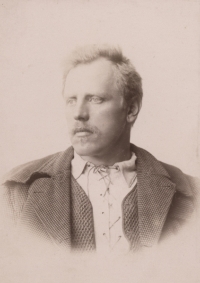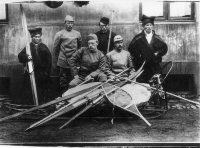1861 - 1930
 Fridtjof Nansen Photo: Norwegian Polar Institute
Fridtjof Nansen Photo: Norwegian Polar Institute
 The Greenland Expedition, 1888. Photo: Norwegian Polar Institute
The Greenland Expedition, 1888. Photo: Norwegian Polar Institute
Polar explorer, scientist, diplomat, international humanist and celebrity
Fridtjof Nansen was born in Aker just outside Christiania (now called Oslo). Nansen studied zoology at the university and after completing his studies, took a position as curator at Bergen Museum. His research ultimately led to a dissertation on the central nervous system of the hagfish. He defended his PhD thesis 28 April 1888, four days before he set off from Oslo to lead the expedition across Greenland.
On skis across Greenland
The plan was to cross the Greenland ice sheet on skis, from the east coast to the west coast, in the opposite direction from what others has tried before him. Nansen had been to the east coast of Greenland before: as a student in 1882 he had sailed with the sealing vessel Viking, and after that he developed a fascination for all things polar. The idea of an expedition across Greenland germinated in 1883. The Greenland Expedition was a huge success – both as a springboard for Norway as a polar nation and for Nansen himself, who became famous both at home and abroad. He also gleaned a lot of knowledge from the expedition, not least because they were obliged to spend the winter with the Inuits on the west coast of Greenland from autumn 1888 to spring 1889. Nansen used his time to study Inuit life and culture, something that later proved beneficial for both Nansen and polar research as a whole.
The Fram Expedition
Nansen’s aim was to prove the existence of ocean currents that cross the Arctic Ocean. He commissioned construction of the polar vessel Fram with the intention of allowing the ship to become icebound and drift with the current over North Pole. The expedition never reached the North Pole, though Nansen and Hjalmar Johansen penetrated farther north than anyone had previously – to 86° 14’. The expedition altered how the academic world perceived the Arctic. Nansen was able to demonstrate that the Arctic Ocean was a deep sea and that it was unlikely to contain any land masses.
The scientific results from the Fram Expedition were published in six volumes between 1900 and 1906.
The diplomat
For several years prior to the dissolution of the Union between Sweden and Norway in 1905, Nansen had taken a close interest in the two countries’ status within the union.
In connection with the dissolution of the Union in 1905, Nansen was sent as an emissary by Prime Minister Christian Michelsen to present Norway’s case in London. In this context Norway benefited from Nansen’s international fame. After his stay in London, Nansen was sent to Copenhagen to persuade the Danish prince Carl to become Norway’s king. Nansen was also Norway’s first ambassador to Great Britain 1906-1908. The most important diplomatic task during this period was to negotiate the Integrity Treaty of 1907, in which the major European powers promised to support Norway against anything that might threaten the country’s independence.
The scientist
After the FramExpedition, Nansen was appointed professor of zoology at the university. He dedicated ever more of his time to oceanography and in 1908 his position at the university was converted to a professorship in oceanography. It was as an oceanographer Nansen did his most important scientific work, and Nansen is considered to be one of the pioneers of modern physical oceanography, not least based on the work “The Norwegian Sea” which he published together with Bjørn Helland-Hansen in 1909.
Nansen was also active in other disciplines, including history and sociology. In 1911 he published the cultural history “In Northern Mists” which describes the history of travel and exploration in the Arctic up to the 1500s. Nansen also wrote a series of books and articles about political issues, both domestic and international.
The Humanitarian
From 1920 until his death, Nansen was a member of the Norwegian delegation to the League of Nations. The League approached Nansen in April 1920 and requested that he organise repatriation of the multitude of war prisoners after World War I.
Nansen led the exchange of 400 000 prisoners of war between Russia, Germany and the former Austro-Hungarian Empire. In 1922 Nansen became the first League of Nations High Commissioner for Refugees. He was also actively involved in aid work in the Soviet Union when famine struck in 1921, efforts for which he was awarded the Nobel Peace Prize in 1922. The League of Nations established the “Nansen Passport”, which allowed stateless refugees to cross national boundaries. Nansen left a significant imprint both in Norway and in many other countries. Fridtjof Nansen died 13 May 1930 and was buried – symbolically enough – 17 May, Norway’s Constitution Day.

